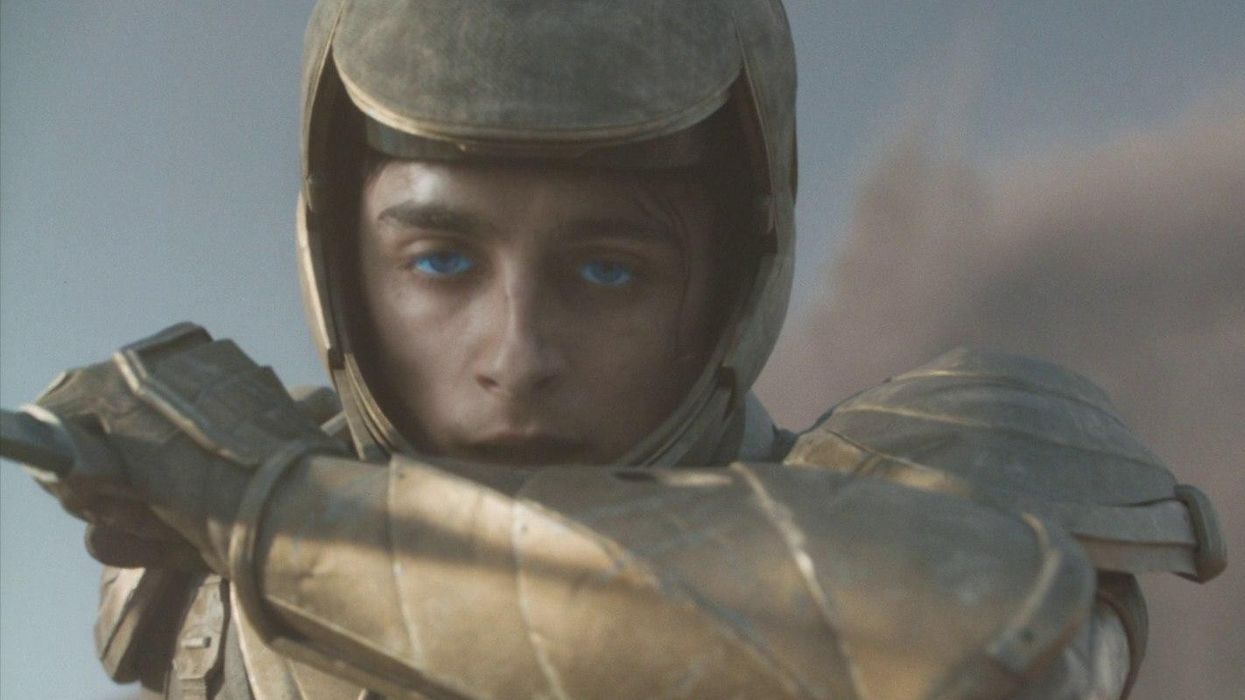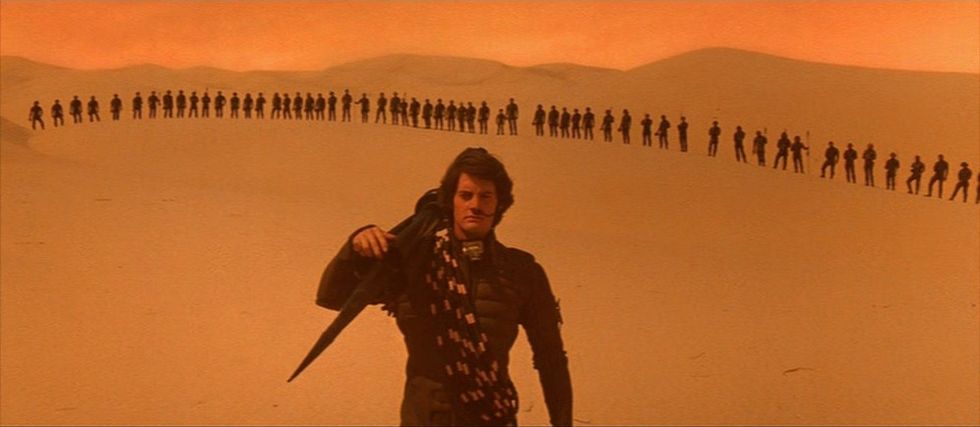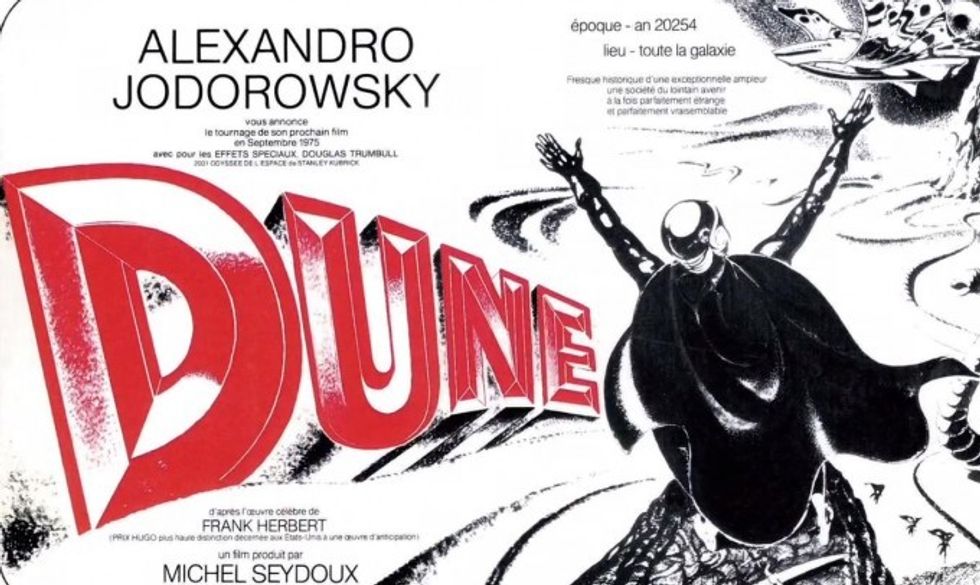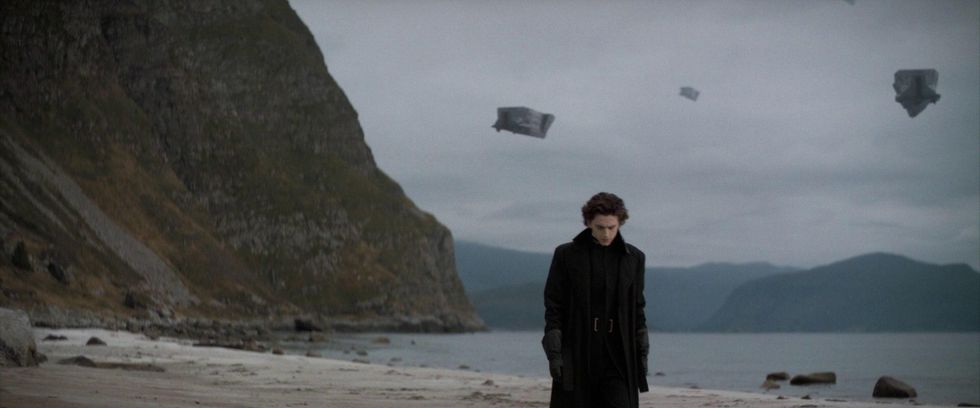What is the Secret History of 'Dune'?
How Alejandro Jodorowsky's failed Dune project paved the way for modern sci-fi and lead the way to Denis Villenueve's exceptional Dune: Part 2.

Denis Villenueve's Dune
Stumbling upon Jodorowsky's Dunewas just about as eye-opening as Paul taking in that first hit of spice taking shelter in the sands of Arrakis (if you know what I'm saying).
It's a documentary that serves as an autobiography of one of the most eccentric, creative auteurs in cinema that amounts to what is essentially an oral history of the sci-fi blockbuster as we know it today. It's also an essential watch for filmmakers on how to develop a film (in grandiose hyperbole), as well as how that can all be stripped away just behind the finish line.
Credit where credit is due: Denis Villenueve's Dune movies rule. Blockbuster spectacles on another level, beautifully rendered adaptations that put modern blockbusters to shame (looking at you, Marvel).
Oh, and shout out to Frank Herbert too, I guess.
But that isn't what this article is about. Again, all due respect to the original text and its most modernest (very pretty) adaptation.But long before Villenueve's Dune, Alejandro Jodorowsky set out to make possibly the most ambitious movie ever made.
The year was 1974, Denis was a wee 7-year-old who hated to read (just kidding), and Jodorowsky, hot off of the success of The Holy Mountain, begin assembling possibly the most bad-ass team of collaborators this side of The Roundhay Garden Scene.
As a fan of El Topo and The Incalgraphic novel I slept on watching Jodorowsky's Dune for far too long. As an altruist gesture, I ask of you: please don't do the same.
Below we break down what makes this documentary so essential, as well as Jodorowsky's lasting impression and the sci-fi genre as we know it.
What is 'Jodorowsky's Dune'?
Chilean director Alejandro Jodorowsky—a uniquely creative artist who came up in avant-garde theatre—started to garner international attention after the release of his first two films, El Topo and The Holy Mountain. When approached by French producer Jean-Paul Gibon if he'd like to make a bigger, more commercial film as his next project Jodorowsky agreed and (somewhat on a whim) decided he wanted to adapt Frank Herbert's Dune.
And so, the rights were acquired, and the Avenger's-like assembly of Jodorowsky's Dune began. In his very whimsical and psychedelically-inclined fashion Jodorowsky wasn't only making a film but "a prophet" to "change the world". (Perhaps a red flag, but give the guy a break).
Keep in mind—in 1974, science fiction was still relatively fringe. This was long before the days of a star war or trek. In fact, without Jodorowsky, who knows if we'd have such beloved sc-fi flagship troopers. But more on that later.
So, long story short, Jodorowsky and his producing partner Michel Seydoux brought together the likes of legendary artists Moebius, H.R. Giger and Chris Foss, then rounded out his cast with Orson Welles, Mick Jagger, Udo Kier, Salvador Dali, and his son, Brontis. Oh and what about music? He successfully recruited french progressive band Magma and Pink Floyd (maybe you've heard of them).
Jodorowsky and Moebius then made a 30x22x9 cm (i.e. very big) Dune bible that essentially doubled as an intricate storyboard that might as well have been a graphic novelized shooting script.
They later collaborated on the incredible The Incal graphic novel, so, you know, they get it.
It's pretty crazy, really, the heart and soul that went into developing this. And why haven't you seen this amazing film, you ask? What happened that made it all far apart?
Too weird, too hard, says Hollywood.
The Jodorowsky to David Lynch to Denis Villenueve Progression

David Lynch's Dune
Warner Bros.
That brings us to the unfortunate mishap that is the mostly maligned, sometimes adored David Lynch adaptation of Dune exactly a decade later in 1984.
David Lynch, as you may know, is not known for his science fiction blockbusters.
In fact, he's known for his subversive art films and deconstructing the hidden evils lurking within suburban society. So, how and why did was he the first director to finish an adaptation of Dune?
Well, think about it. Several studios have their hands on Jodorowsky and Moebius's bible (only 20 exist, but in the hands of executives). Their vision is, for lack of a better word, "weird". And a young David Lynch just made The Elephant Man—a "weird" and successful blockbuster level narrative.
Are you with me here?
Not to mention many of the designs used in Lynch's Dune either resemble or directly are pulled from the Jodorowsky bible, it's not crazy to say that Jodorowsky was completely alienated high-and-dry, and a studio hired the closest director to Jodorowsky's whimsey they could get ahold of and re-craft.
Perhaps a major studio, perhaps one named Warner Brother, was attempting to cash in on the success of Star Wars with the very thing that inspired it? Maybe.
Fast forward 37-some years and nine Star Wars later, the sci-fi blockbuster landscape is very, very far away from where it used to be. Sci-fi is commercialized, beloved, and not as fringe as it used to be.
We have not only Star Wars, but Star Trek, Alien, Terminator, Minority Report, Blade Runner, ad nausea, leading the way for a Mr. Denis Villenueve makes a name for himself as a visual mastermind behind modern science fiction masterpieces Arrival and Blade Runner: 2049.
What better time to remake Dune—in two parts!
Jodorwsky's Influence On Sci-Fi at Large

Alejendro Jodorowsky's Dune
As broken down in Jodorwsky's Dune, Jodorowsky's influence is undeniable in science fiction through the last four decades.
From direct costume designs in Flash Gordon and He-Man: Master's of The Universe, to shots never-before-done in film that are found in the Jorodowsky-Moebius Dune bible in Terminator, Minority Report, and Blade Runner.
Not to mention, um, a lotttttt of influence scattered throughout Star Wars, including some partiuclarly hard to miss story beats, as well as shots found in their Dune bible.
In many ways too we have Jodorowsky to thank for Alien, uniting Dan O'Bannon (Alien writer) and H.R. Giger (Alien creature/production design).
It's a real tragedy we don't get to see the insane artistic spectacle Jodorowsky would have created, but it isn't without its tangential achievements. And, the multi-gendered Supreme Being in the sky bless his heart, Jodorowsky is a pretty good sport about it. He's proud of his influence, and pivoted to creating graphic novels where he has complete creative control.
Remember that as you enjoy your AMC Sandworm Cups.
What's The Lesson Here?

Denis Villenueve's Dune
Warner Bros.
Be careful!
Not everyone in Hollywood is conniving, but there are many stories of smart, creative people taken advantage of or had IP stolen from them. Protect your ideas and make sure the big wigs your showing your work to have your best interest in mind.
And, hey. Enjoy Dune: Part 2. It took a lot of artistic strife to get this kind of movie made.
- Check Out Some Amazing Stills from Jodorowsky's 'Dune' ›
- Why 'Dune' Was Shot on Digital, Transferred to 35mm, Then Scanned to Digital ›
- What Is 'Dune' About? 'Dune' Characters, Symbols, Terminology, and Meaning Explained ›
- Some Buffoons Bought a 'Dune' Book and Mistakenly Thought They Owned the IP ›











